Site pages
Current course
Participants
General
Module 1. Average and effective value of sinusoida...
Module 2. Independent and dependent sources, loop ...
Module 3. Node voltage and node equations (Nodal v...
Module 4. Network theorems Thevenin’ s, Norton’ s,...
Module 5. Reciprocity and Maximum power transfer
Module 6. Star- Delta conversion solution of DC ci...
Module 7. Sinusoidal steady state response of circ...
Module 8. Instantaneous and average power, power f...
Module 9. Concept and analysis of balanced polypha...
Module 10. Laplace transform method of finding ste...
Module 11. Series and parallel resonance
Module 12. Classification of filters
Module 13. Constant-k, m-derived, terminating half...
LESSON 30. Constant-k filters
30.1. Constant – K Low Pass Filter
A network, either T or \[\pi\], is said to be of the constant-k type if Z1 and Z2 of the network satisfy the relation
Z1Z2 = k2 \[...................................................\left( {30.1} \right)\]
where Z1 and Z2 are impedance in the T and \[\pi\] sections as shown in Fig.17.8. Equation 17.20 states that Z1 and Z2 are inverse if their product is a constant, independent of frequency. k is a real constant, that is the resistance. k is often termed as design impedance or nominal impedance of the constant k-filter.
The constant k, T or \[\pi\] type filter is also known as the prototype because other more complex networks can be derived from it. A prototype T and \[\pi\]-sections are shown in
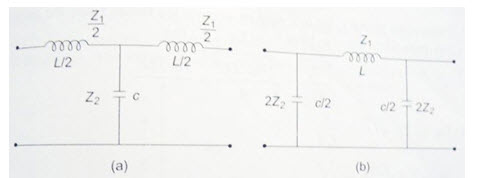
Fig. 30.1
Fig.30.1 (a) and (b), where Z1 = jωL and Z2 = 1/jωC. Hence Z1Z2= \[{L \over C}={k^2}\] which is independent of frequency.
\[{Z_1}{Z_2}={k^2}={L \over C}\,\,\,or\,\,k=\sqrt {{L \over C}} ...................................................\left( {30.2} \right)\]
Since the product Z1 and Z2 is constant, the filter is a constant-k type. From Eq. 29.8 (a) the cut-off frequencies are Z1/4Z2 = 0.
i.e. \[{{ - {\omega ^2}LC} \over 4}=0\]
i.e. \[f=0\,\,and\,\,{{{Z_1}} \over {4{Z_2}}}=-1\]
\[{{ - {\omega ^2}LC} \over 4}=-1\]
or \[{f_c}={1 \over {\pi \sqrt {LC} }}...................................................\left( {30.3} \right)\]
The pass band can be determined graphically. The reactances of Z1 and 4Z2 will vary with frequency as drawn in Fig.30.2. The cut-off frequency at the intersection of the curves Z1 and 4Z2 is indicated as ƒc. On the X-axis as Z1 = -4Z2 at cut-off frequency, the pass band lies between the frequencies at which Z1 = 0, and Z1=-4Z2.
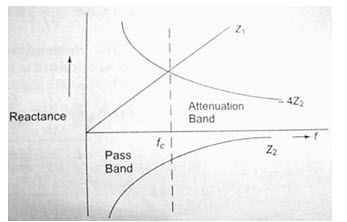
Fig.30.2
All the frequencies above ƒc lie in a stop or attenuation band. Thus, the network is called a low-pass filter. We also have from Eq.28.7 (previous chapter) that
\[\sinh {\gamma\over 2}=\sqrt {{{{Z_1}} \over {4{Z_2}}}}=\sqrt {{{ - {\omega ^2}LC} \over 4}}={{J\omega \sqrt {LC} } \over 2}\]
From Eq. 30.3 \[\sqrt {LC}={1 \over {{f_c}\pi }}\]
\[\sinh {\gamma\over 2}={{j2\pi f} \over {2\pi {f_c}}}=j{f \over {{f_c}}}\]
We also know that in the pass band
\[-1<{{{Z_1}} \over {4{Z_2}}}< 0\]
\[-1<{{ - {\omega ^2}LC} \over 4}< 0\]
\[-1<-\left( {{f \over {{f_c}}}} \right)< 0\]
or \[{f \over {{f_c}}} < 1\]
and \[\beta=2{\sin ^{ - 1}}\left( {{f \over {{f_c}}}} \right);\,\,\alpha=0\]
In the attenuation band,
\[{{{Z_1}} \over {4{Z_2}}}<-1,\,\,i.e.{f \over {{f_c}}} < 1\]
\[\alpha=2{\cosh ^{ - 1}}\left[ {{{{Z_1}} \over {4{Z_2}}}} \right]=2{\cosh ^{ - 1}}\left[ {{f \over {{f_c}}}} \right];\,\beta=\pi\]
The plots of \[\alpha\] and β for pass and stop bands are shown in Fig.30.3.
Thus, from Fig.30.3, a = 0, b = 2 sinh-1 \[\left( {{f \over {{f_c}}}} \right)for\,\,f < {f_c}\]
\[\alpha=2{\cosh ^{ - 1}}\left( {{f \over {{f_c}}}} \right);\,\beta=\pi \,\,for\,\,f > fc\,\,f < {f_c}\]
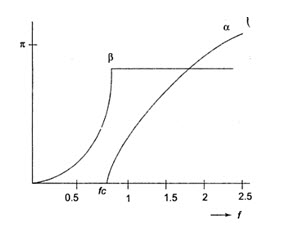
Fig.30.3
The characteristic impedance can be calculated as follows.
\[{Z_{0T}}=\sqrt {{Z_1}{Z_2}\left( {1 + {{{Z_1}} \over {4{Z_2}}}} \right)}\]
\[=\sqrt {{L \over C}\left( {1 + {{{\omega ^2}LC} \over 4}} \right)}\]
\[{Z_{0T}}=k{\sqrt {1 - \left( {{f \over {{f_c}}}} \right)} ^2}...................................................\left( {30.4} \right)\]
From Eq.30.4, Z0T is real when ƒ < ƒc i.e. in the pass band at ƒ = ƒc, Z0T = 0; and for ƒ > ƒc, Z0T is imaginary in the attenuation band, rising to infinite reactance at infinite frequency. The variation of Z0T with frequency is shown in Fig.30.4.
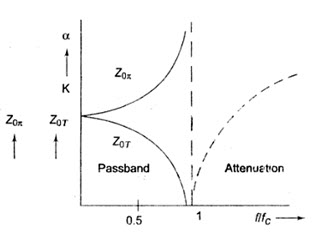
Fig.30.4
Similarly, the characteristic impedance of a \[\pi\]-network is given by

The variation of Z0\[\pi\] with frequency is shown in fig. 30.4 for ƒ< ƒc, Z0\[\pi\] is real; at ƒ = ƒc, Z0\[\pi\] is infinite, and for ƒ > ƒc, Z0T is imaginary. A low pass filter can be designed from the specifications of cut-off frequency and load resistance.
All cut-off frequency, Z1= -4Z2
\[j{\omega _c}L={{ - 4} \over {j{\omega _c}C}}\]
\[{\pi ^2}f_c^2LC=1\]
Also we know that \[k=\sqrt {L/C}\] is called the design impedance or the load resistance
\[{k_2}={L \over C}\]
\[{\pi ^2}f_c^2{k^2}{C^2}=1\]
\[C={1 \over {\pi \,{f_c}k}}\,gives\,\,the\,\,value\,\,of\,\,the\,\,shunt\,capaci\tan ce\]
\[and\,L={k^2}C={k \over {\pi {f_c}}}\,gives\,the\,value\,of\,the\,series\,induc\tan ce.\]
30.2. Constant K-High Pass Filter
Constant K-high pass filter can be obtained by changing the positions of series and shunt arms of the networks shown in Fig.30.1. The prototype high pass filters are shown in Fig.30.5, where Z1 =-j/ωC and Z2 = jωL.
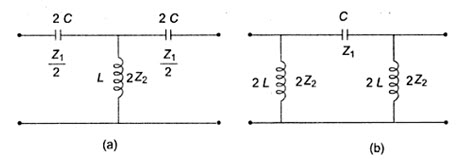
Fig.30.5
Again, it can be observed that the product of Z1 and Z2 is independent of frequency, and the filter design obtained will be of the constant k type. Thus, Z1Z2 are given by
\[{Z_1}{Z_2}={{ - j} \over {\omega C}}j\omega L={L \over C}={k^2}\]
The cut-off frequencies are given by Z1= 0 and Z1 =-4Z2.
\[{Z_1}\,=\,0\,indicates\,{j \over {\omega C}}=0,\,\,or\,\,\omega\to \alpha\]
From Z1 =-4Z2
\[{{ - j} \over {\omega C}}=-4j\omega L\]
\[{\omega ^2}LC={1 \over 4}\]
or \[{f_c}={1 \over {4\pi \sqrt {LC} }}...................................................\left( {30.6} \right)\]
The reactance of Z1 and Z2 are sketched as functions of frequency as shown in Fig.30.6.
As seen from Fig.30.6, the filter transmits all frequencies between ƒ = ƒc and ƒ = \[\propto\] . The point ƒc from the graph is a point at which Z1 = -4Z2.
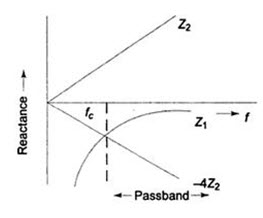
Fig.30.6
\[\sinh {\gamma\over 2}=\sqrt {{{{Z_1}} \over {4{Z_2}}}}=\sqrt {{{ - 1} \over {4{\omega ^2}LC}}}\]
\[From\,Eq.17.25,{f_c}={1 \over {4\pi \sqrt {LC} }}\]
\[\sqrt {LC}={1 \over {4\pi {f_c}}}\]
\[\sinh {\gamma\over 2}=\sqrt {{{ - {{\left( {4\pi } \right)}^2}{{\left( {{f_c}} \right)}^2}} \over {4{\omega ^2}}}}=j{{{f_c}} \over f}\]
In the pass band, \[- 1 < {{{Z_1}} \over {4{Z_2}}} < 0,\alpha=0\,\,or\,the\,region\,which\,{{{f_c}} \over f} < 1\,is\,a\,pass\,band\]
\[\beta=2{\sin ^{ - 1}}\left( {{{{f_c}} \over f}} \right)\]
In the attenuation band \[{{{Z_1}} \over {4{Z_2}}}<-1,i.e.{{{f_c}} \over f} > 1\]
\[\alpha=2{\cosh ^{ - 1}}\left( {{{{Z_1}} \over {4{Z_2}}}} \right)\]
\[=2{\cos ^{ - 1}}\left( {{{{f_c}} \over f}} \right);\,\,\beta=-\pi\]
The plots of a and b for pass and stop bands of a high pass filter network are shown in Fig.30.7
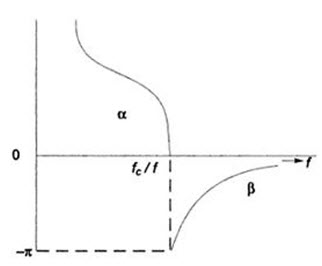 Fig.30.7
Fig.30.7
A high pass filter may be designed similar to the low pass filter by choosing a resistive load r equal to the constant k, such that \[R=k=\sqrt {L/C}\]
\[{f_c}={1 \over {4\pi \sqrt {L/C} }}\]
\[{f_c}={k \over {4\pi L}}={1 \over {4\pi Ck}}\]
Since \[\sqrt C={L \over k},\]
\[L={k \over {4\pi {f_c}}}and\,C={1 \over {4\pi {f_c}k}}\]
The characteristic impedance can be calculated using the relation
\[{Z_{0T}}=\sqrt {{Z_1}{Z_2}\left( {1 + {{{Z_1}} \over {4{Z_2}}}} \right)}=\sqrt {{L \over C}\left( {1 - {1 \over {4{\omega ^2}LC}}} \right)}\]
\[{Z_{0T}}=k\sqrt {1 - {{\left( {{{{f_c}} \over f}} \right)}^2}}\]
Similarly, the characteristic impedance of a p-network is given by
\[{Z_{0\pi }}={{{Z_1}{Z_2}} \over {{Z_{0T}}}}={{{k_2}} \over {{Z_{0T}}}}\]

The plot of characteristic impedance with respect to frequency is shown in Fig.30.8
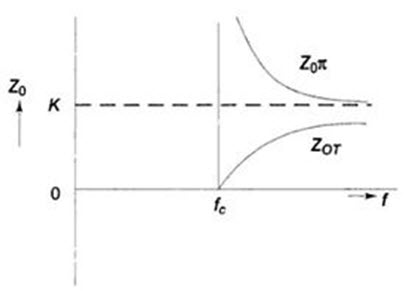
Fig.30.8